On the surface, comparing the Philips Sonicare and Oral-B ranges of electric toothbrushes looks like comparing apples and oranges. Apples and oranges are definitely fruits, but they are definitely not the same. Sonicare and Oral-B are definitely electric toothbrushes but they give their technologies different names. They have different features, price brackets, strengths, and weaknesses that make it a little difficult to compare like for like, but that is what we will try to do here.
The first question is why compare them in the first place? Well, the simple fact is that they are the two best-known brands and have been popular for some years. They are the ones that you are most likely to find on supermarket shelves and popping up in online searches.

If you want a generalized comparison, you could say that Oral-B is the one that comes with more box contents and costs less. Sonicare often looks better, has longer battery life at around 3 weeks compared to Oral-B’s 2, and costs more. That’s kind of right but also a bit simplistic, and people are motivated to buy some products over others because of a variety of factors such as quality, budget, personal design preferences; the list goes on, so we have to dig deeper.
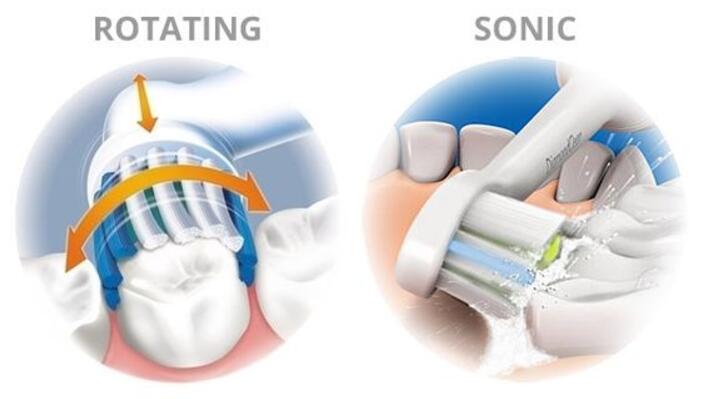
The brushing technology used by each brand is slightly different. Philips uses its sonic technology, which is to say it has a side-to-side brushing motion that mimics a regular toothbrush, complemented by brush head vibration that is intense enough to agitate the fluids and particles of food around teeth. Just as music can make beads dance on an upturned loudspeaker, so the sonic technology’s vibrations can loosen plaque and debris that’s hiding deep between teeth and out of the reach of bristles. Most Sonicare models move at around 31,000 times a minute while some premium models can reach 62,000, depending on which cleaning mode is used. Phillips brush heads typically look like those of a manual toothbrush in size and shape.
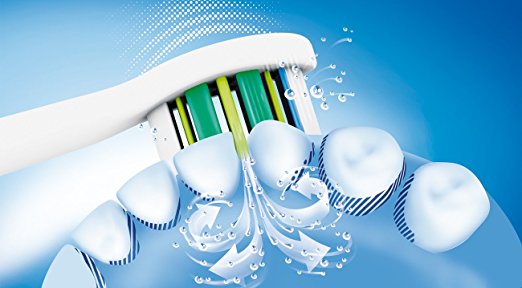
Oral-B brush heads use oscillation and rotation to clean teeth. They are noticeably smaller and rounder, and they rotate the bristles a few degrees one way, and then a few degrees the other to get rid of plaque and food debris. Oral-B calls this oscillating and rotating movement “2-D” as it moves in only one plane. Its 3-D brushes are so-called because they also pulse in a third plane so there is an extra dimension to their cleaning movement. This aspect of the movement brings them a little closer to what Phillips offers.
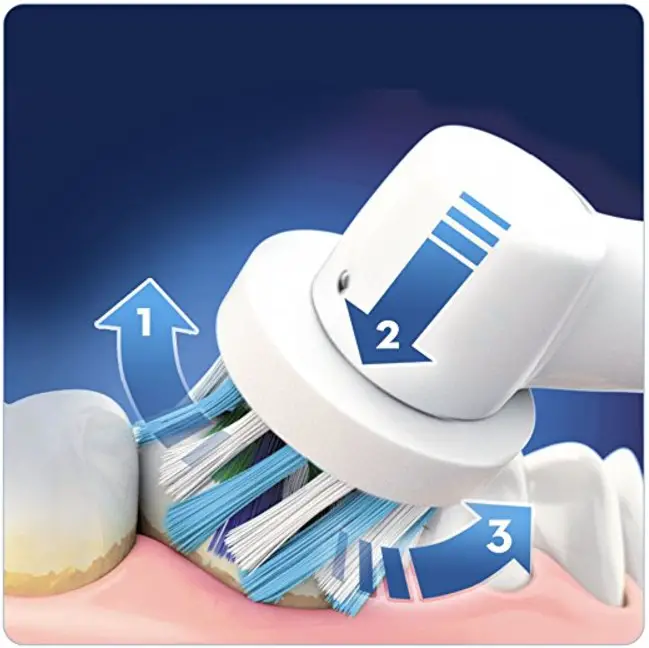
It is not clear from clinical studies which system works better for cleaning teeth, so your choice will probably come down to which feels better to you. Oral-B can feel a little bit harsher, while Sonicare’s faster-moving brushes tend to feel softer. Both will leave your teeth feeling clean enough that it is hard to tell which does the better job.
In terms of design, Sonicare brushes are slightly more clinical with a rubber grip, but look better because of attention to detail. Phillips uses color accents and makes sure that heads match to handles, which is not always the case with Oral-B.
Oral-B handles are generally glossy with a rubber grip at the front that comes in various colors, and it helps the brush to look less clinical than its competitor.
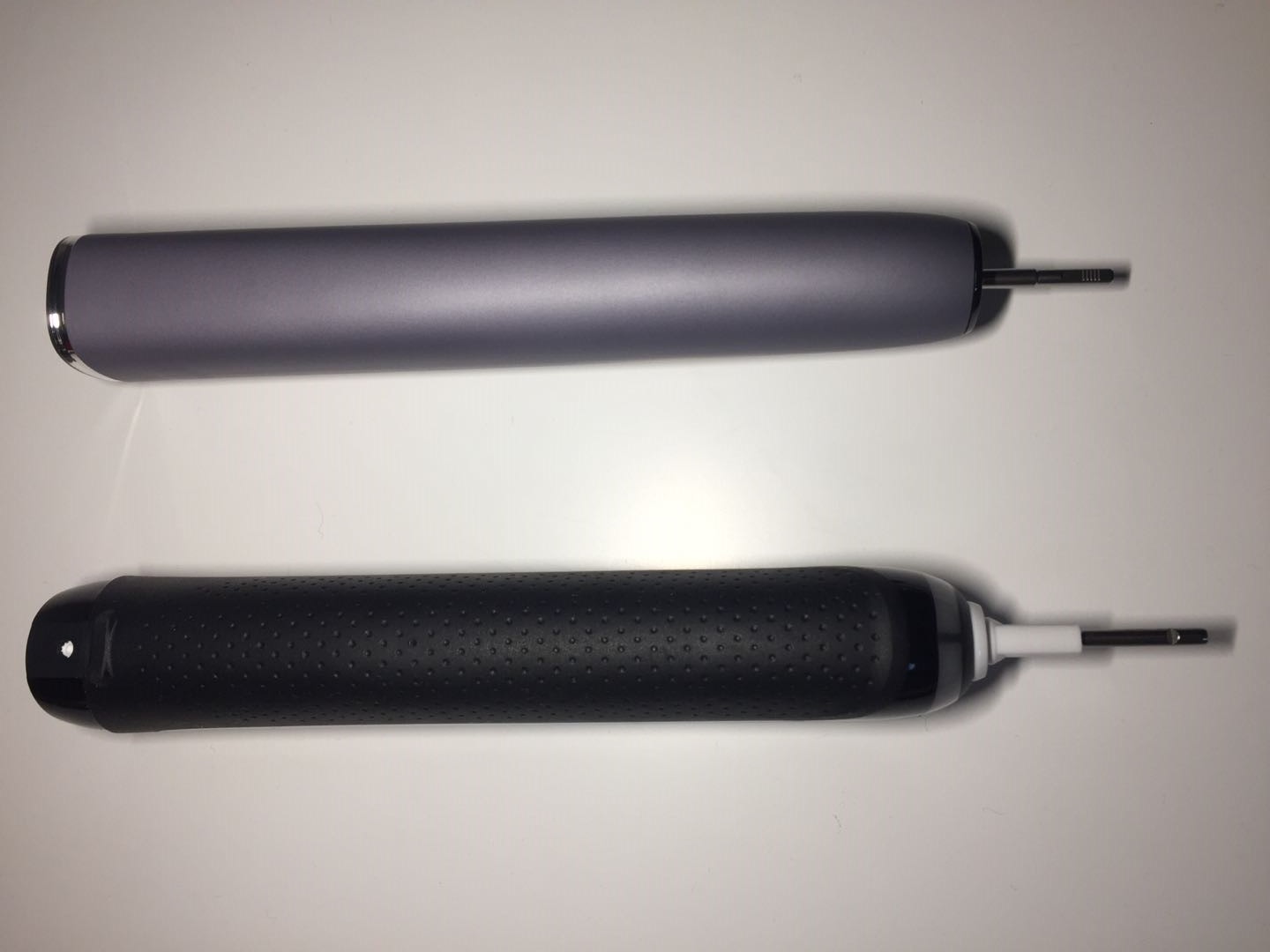
While features like brushing apps, Bluetooth, cleaning modes, pressure sensors, and timers are available with both brands, you pay less to get them with Oral-B.
Top series: Genius Pro 8000 vs DiamondClean/DiamondClean Smart
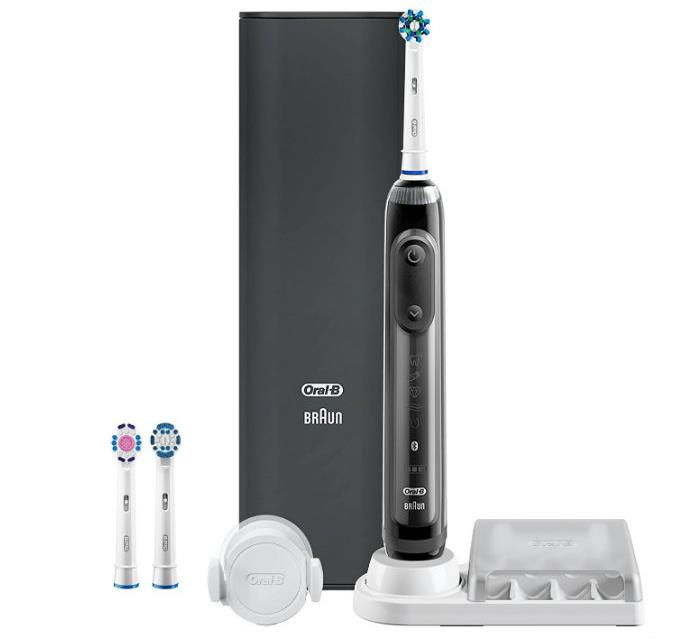 The Pro 8000 model offers an attractive black handle that feels comfortable in the hand. Its pressure sensor shows a bright colored light (and there are 12 colors to choose from) on its SmartRing.
The Pro 8000 model offers an attractive black handle that feels comfortable in the hand. Its pressure sensor shows a bright colored light (and there are 12 colors to choose from) on its SmartRing.
It gives you 6 different brushing modes and claims to remove 500% more plaque than a manual toothbrush. The modes are called Sensitive, Whitening (best used with the 3D White brush head), 3D Daily Clean (which oscillates, rotates, and pulsates as described above) Gum Care, Tongue Clean and Pro-Clean (3000 more movements per minute).
The Pro 8000 can connect to your phone via Bluetooth, and while it sits stuck to your bathroom wall thanks to the suction cup on the provided cradle, the phone app gives you brushing guidance and records your history to share later with your dentist. You get a nice travel case with USB charging (very handy) and a storage compartment for brush heads. It manages 12 days of brushing per charge.
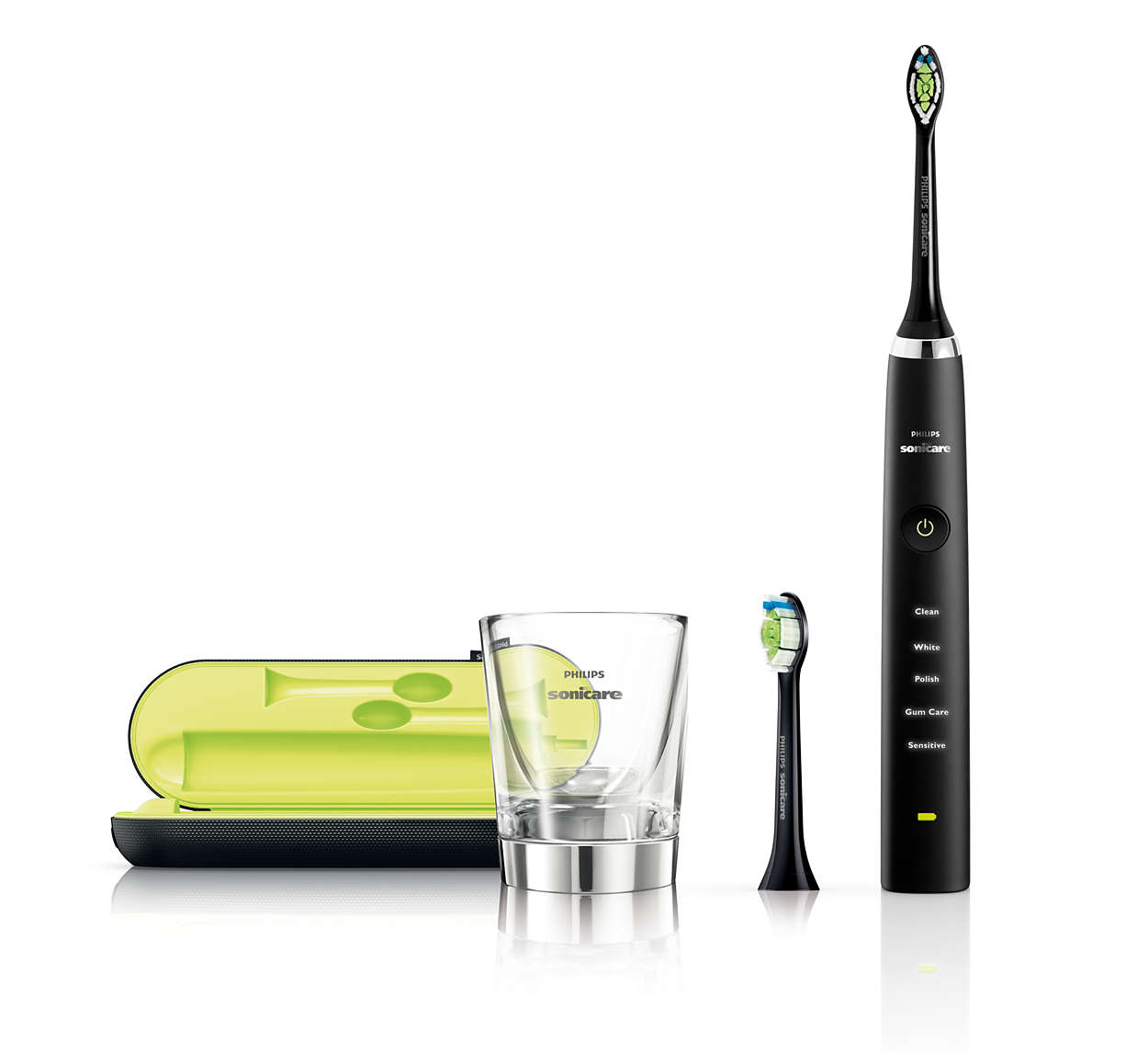 Contrast this with the Philips Sonicare DiamondClean and you’ll see that these high-end brushes are almost neck and neck. The DiamondCleans have 5 cleaning modes called Clean, White, Sensitive, Gum Care, and Deep Clean. So, one less cleaning mode brings up the question of whether you really need a mode dedicated to your tongue? (Probably not). Battery life is better at 3 weeks when fully charged via the attractive glass charger or the travel case with a USB port.
Contrast this with the Philips Sonicare DiamondClean and you’ll see that these high-end brushes are almost neck and neck. The DiamondCleans have 5 cleaning modes called Clean, White, Sensitive, Gum Care, and Deep Clean. So, one less cleaning mode brings up the question of whether you really need a mode dedicated to your tongue? (Probably not). Battery life is better at 3 weeks when fully charged via the attractive glass charger or the travel case with a USB port.
The different brushing modes and choice of heads give you similar options to the Oral-B Genius Pro 8000 and it’s hard to tell the difference between the level of cleaning they both give.
The DiamondClean is missing Bluetooth, so there’s no smartphone app to guide your brushing and no pressure sensor. It does have an ‘Easy Start’ option, which slowly raises the brushing speed for the first 14 sessions so that new users can get a gentle introduction to electric brushing.
If you want the missing features that the Oral-B supplies as standard you will have to buy the much pricier Smart version of the DiamondClean, so Oral-B wins this round.
High-end: FlexCare Platinum Connected vs Pro 7000
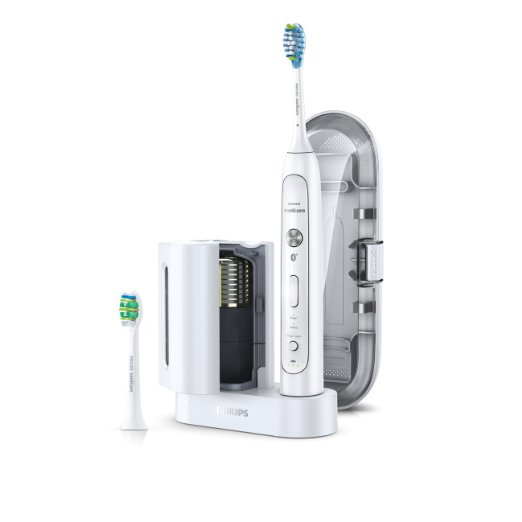 At the next tier down, we have the FlexCare Platinum Connected which has 3 cleaning settings (Clean, White, and Deep Clean) and 3 intensity settings. It includes 1 x AdaptiveClean brush head and a basic travel case. It also comes with a UV sanitizer. It’s another Phillips brush with an attractive design, the handle having prominent buttons including a large silver power switch for a clinical feel. Built-in location sensor, pressure sensor, and scrubbing sensor link via Bluetooth to the smartphone app. Basically, it knows where you are brushing and for how long, and it can show you, so you will know if there are sections that you skipped. It monitors brush heads and alerts you when you need to replace them, so long as they are the more expensive smart-enabled brush heads. RRP is around $200.
At the next tier down, we have the FlexCare Platinum Connected which has 3 cleaning settings (Clean, White, and Deep Clean) and 3 intensity settings. It includes 1 x AdaptiveClean brush head and a basic travel case. It also comes with a UV sanitizer. It’s another Phillips brush with an attractive design, the handle having prominent buttons including a large silver power switch for a clinical feel. Built-in location sensor, pressure sensor, and scrubbing sensor link via Bluetooth to the smartphone app. Basically, it knows where you are brushing and for how long, and it can show you, so you will know if there are sections that you skipped. It monitors brush heads and alerts you when you need to replace them, so long as they are the more expensive smart-enabled brush heads. RRP is around $200.
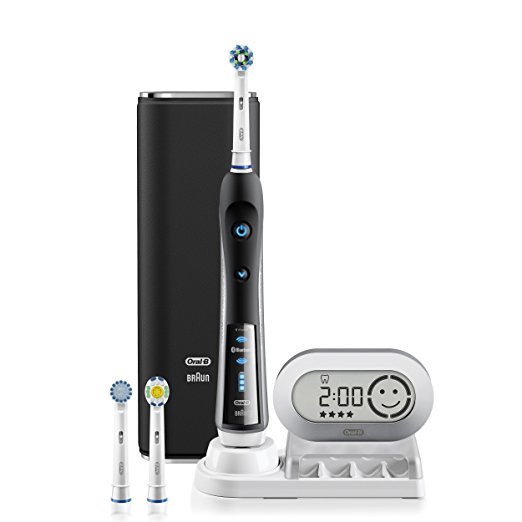 The Oral-B Pro 7000 comes in Black or White and is closer to $120. For that you get a charging station, brush head storage compartment, CrossAction x 2, Floss Action x 1, Pro White/3D White x 1 and Sensitive x 1) wireless Smart Guide, premium travel case. 6 cleaning modes (Daily Clean, Gum Care, Sensitive, Whitening, Deep Clean and Tongue Cleaner). It has a visible pressure sensor, cleaning timer with Quadpacer for timed brushing. You get decent contents in the box and plenty of cleaning modes to suit different mouths. 10 days of battery life is not as good as the Phillips brush but that is something that you come to expect. It has a pressure sensor that shines red if you press too hard on a separate wireless clock and timer unit that displays your cleaning mode, how well and for how long you have been brushing. It’s cheaper than the FlexCare Platinum and brushes about as well, but the separate timer is obviously less advanced than any smartphone. Also, the black option is let down by the lack of a black matching brush head.
The Oral-B Pro 7000 comes in Black or White and is closer to $120. For that you get a charging station, brush head storage compartment, CrossAction x 2, Floss Action x 1, Pro White/3D White x 1 and Sensitive x 1) wireless Smart Guide, premium travel case. 6 cleaning modes (Daily Clean, Gum Care, Sensitive, Whitening, Deep Clean and Tongue Cleaner). It has a visible pressure sensor, cleaning timer with Quadpacer for timed brushing. You get decent contents in the box and plenty of cleaning modes to suit different mouths. 10 days of battery life is not as good as the Phillips brush but that is something that you come to expect. It has a pressure sensor that shines red if you press too hard on a separate wireless clock and timer unit that displays your cleaning mode, how well and for how long you have been brushing. It’s cheaper than the FlexCare Platinum and brushes about as well, but the separate timer is obviously less advanced than any smartphone. Also, the black option is let down by the lack of a black matching brush head.
The pros and cons of these two cancel each other out so it really is best to toss a coin and go with the one you prefer. You will get what you pay for!
Mid-range: Healthy White vs Pro 5000
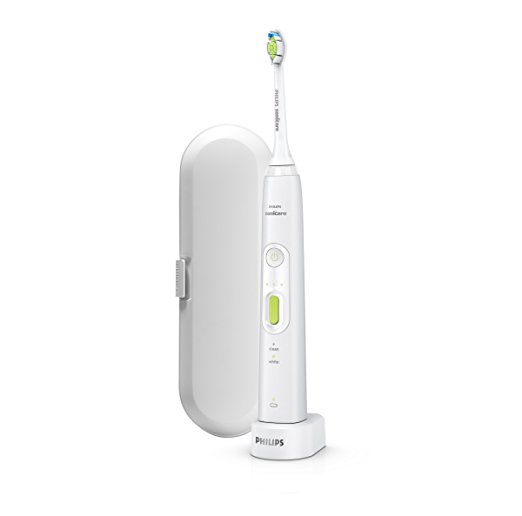 The Sonicare HealthyWhite+ has been on the market for a while now and is still a popular medium-priced electric toothbrush. For around $120 dollars you get one brush head (the Diamond clean for whitening), Quadpacer (thirty-second interval timer), Smartimer, (two-minute timer) and 2 cleaning modes, Clean and White. There are also three intensities which you can change by pressing an oblong plus and minus button.
The Sonicare HealthyWhite+ has been on the market for a while now and is still a popular medium-priced electric toothbrush. For around $120 dollars you get one brush head (the Diamond clean for whitening), Quadpacer (thirty-second interval timer), Smartimer, (two-minute timer) and 2 cleaning modes, Clean and White. There are also three intensities which you can change by pressing an oblong plus and minus button.
It offers Philips’s familiar 31000 brush movements per minute to remove 7 times as much plaque as a manual toothbrush and clear up to 90% of stains. There is no pressure sensor, but that is typical of Phillips brushes at this price point. And that is it! Not a great deal on offer there, but it does clean your teeth well.
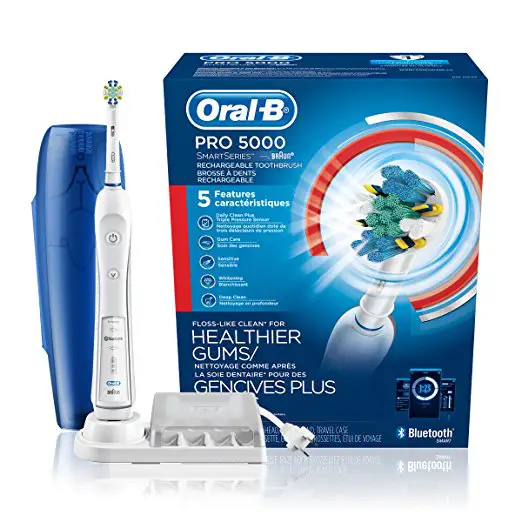 By contrast, the Oral-B Pro 5000 costs around $160 on paper, but you will find that some retailers are offering discounts which bring the price go down to half that. of the Healthy White+. It comes with a Floss Action round brush head with “micropulse” for a better interdental clean, and it has a pressure sensor that tells you with a light (and via your smartphone) that you should ease off. It has 5 brushing modes: are Daily Clean, Gum Care, Sensitive, Whitening, and Deep Clean
By contrast, the Oral-B Pro 5000 costs around $160 on paper, but you will find that some retailers are offering discounts which bring the price go down to half that. of the Healthy White+. It comes with a Floss Action round brush head with “micropulse” for a better interdental clean, and it has a pressure sensor that tells you with a light (and via your smartphone) that you should ease off. It has 5 brushing modes: are Daily Clean, Gum Care, Sensitive, Whitening, and Deep Clean
The 3-D cleaning action feels as if it is in the same league as Phillips’s sonic technology, and the floss action is good for interdental cleaning. So, overall this seems like the better brush. 2 extra brushing modes and high-end features like Bluetooth help it outshine the Health Clean+. The only pity of it is the Oral-B’s usual poor battery life
Mid-range: 3 Series Gum Health vs Pro 3000
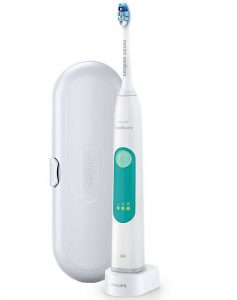 A little further down the mid-range, we come to the Philips Sonicare 3 Series Gum Health. The list prices $89.99 but expect to find them on Amazon for just under $60. Its main claim is that it improves gum health up to 100% better than a manual toothbrush. Not surprisingly the pack includes 1 ProResults gum health brush head and the handle is simplicity itself with a large rubber on/off switch that also lets you cycle through the 3 brushing speeds with subsequent presses. These let you brush more slowly for a more comfortable experience if you have sensitive teeth. Philips claims the brush will remove up to 6 times more plaque along the gumline than a manual toothbrush. Their patented sonic technology gives up to 31,000 brush strokes per minute and 2-color battery charge indicator tells you when it’s time to recharge. The battery will allow you to keep on brushing for 3 weeks as we’ve come to expect.
A little further down the mid-range, we come to the Philips Sonicare 3 Series Gum Health. The list prices $89.99 but expect to find them on Amazon for just under $60. Its main claim is that it improves gum health up to 100% better than a manual toothbrush. Not surprisingly the pack includes 1 ProResults gum health brush head and the handle is simplicity itself with a large rubber on/off switch that also lets you cycle through the 3 brushing speeds with subsequent presses. These let you brush more slowly for a more comfortable experience if you have sensitive teeth. Philips claims the brush will remove up to 6 times more plaque along the gumline than a manual toothbrush. Their patented sonic technology gives up to 31,000 brush strokes per minute and 2-color battery charge indicator tells you when it’s time to recharge. The battery will allow you to keep on brushing for 3 weeks as we’ve come to expect.
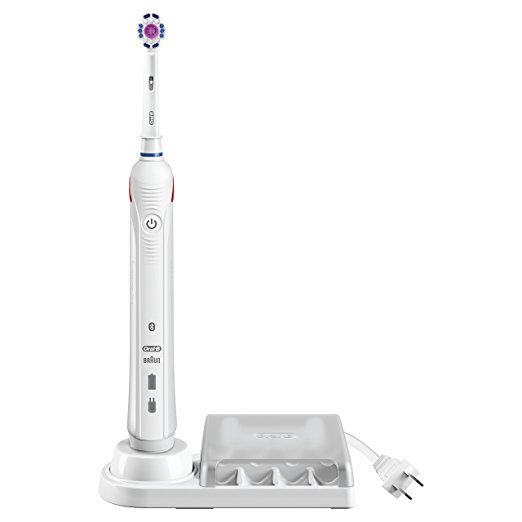 Though it’s around $80, Oral-B’s Pro 3000 still manages to offer Bluetooth technology and the smartphone app for daily monitoring of personalized brushing routines. This handle has an inbuilt 2-minute brushing timer with thirty-second buzzer intervals to let you know when to change quadrant. It has 3 brushing modes: Daily Clean, Sensitive and Whitening. It also has a pressure sensor and visible red light. It comes with a bigger stand than the Philips with spaces to hold extra brush heads but this is a little obtrusive in appearance and is not that appealing.
Though it’s around $80, Oral-B’s Pro 3000 still manages to offer Bluetooth technology and the smartphone app for daily monitoring of personalized brushing routines. This handle has an inbuilt 2-minute brushing timer with thirty-second buzzer intervals to let you know when to change quadrant. It has 3 brushing modes: Daily Clean, Sensitive and Whitening. It also has a pressure sensor and visible red light. It comes with a bigger stand than the Philips with spaces to hold extra brush heads but this is a little obtrusive in appearance and is not that appealing.
Even if you can’t find the Pro 3000 at a discount, it still feels like it offers better value than the less well-featured Phillips offering. The version with the contrasting blue rubber sleeve on the handle also visibly looks better than the somewhat dull 3 Series Gum Health, so once again this feels like a victory for Oral-B.
Low-End: 2 Series Plaque Control vs Pro 1000
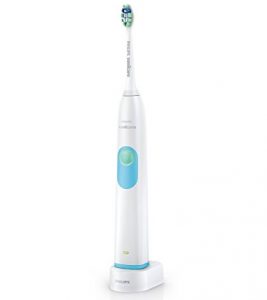 At the entry-level, Philips is offering the 2 Series Plaque Control. The list price for this model is $69.99 but it may be available for $39.95 at some retailers. It has another basic-looking white handle with a green on/ off switch, and it comes with 1 ProResults plaque control brush head, claiming to remove up to six times more plaque than manual brushing.
At the entry-level, Philips is offering the 2 Series Plaque Control. The list price for this model is $69.99 but it may be available for $39.95 at some retailers. It has another basic-looking white handle with a green on/ off switch, and it comes with 1 ProResults plaque control brush head, claiming to remove up to six times more plaque than manual brushing.
Its main selling point is the sonic technology that gives 31,000 brush strokes a minute and causes fluid to penetrate along the gum-line and between teeth. It includes an “easy start” mode for a gentle introduction to brushing and two-minute Smartimer in line with dentist recommendations. There’s a battery charge indicator to tell you when to recharge and battery life is said to be 2 weeks.
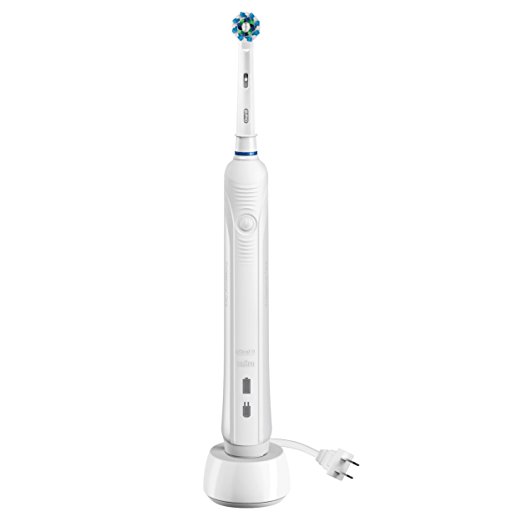 The Oral-B Pro 1000 can be had for closer to $30. It uses the three-way 3-D movement to deep clean teeth, has a 2-minute timer with pulses at 30-second intervals to change brushing quadrant. It also has a pressure sensor which stops pulsing when you brush too hard. There is no storage for extra brush heads so that could be a problem if you have a family sharing one brush. Another detractor is the very bright recharge light, which might be visible from a bedroom if there aren’t doors in the way. With similar brushing technologies, or at least technologies that yield similar results, similar prices and even similar battery life, there is not much to choose between them. If the pressure sensor is something you value and it may make the Oral-B more appealing, but in truth, they both do a good job of cleaning your teeth and there is not much between them.
The Oral-B Pro 1000 can be had for closer to $30. It uses the three-way 3-D movement to deep clean teeth, has a 2-minute timer with pulses at 30-second intervals to change brushing quadrant. It also has a pressure sensor which stops pulsing when you brush too hard. There is no storage for extra brush heads so that could be a problem if you have a family sharing one brush. Another detractor is the very bright recharge light, which might be visible from a bedroom if there aren’t doors in the way. With similar brushing technologies, or at least technologies that yield similar results, similar prices and even similar battery life, there is not much to choose between them. If the pressure sensor is something you value and it may make the Oral-B more appealing, but in truth, they both do a good job of cleaning your teeth and there is not much between them.
Unique Functions
Oral-B brushes use a rotary action, so the brush heads are round out of necessity and the bristles are arranged in a circular pattern, canted at 16 degrees from the vertical as this is apparently the optimum effective angle. Brush heads are small too, so there is an advantage there for people with smaller mouths.
Its 3d technology pulsates the brush head 40,000 times and oscillates it 8,800 a minute. Its 2d technology (used in the vitality series) oscillates it 7,600 times per minute.
Sonicare brushes vibrate at 260 times per second, which can be expressed as 260hz. This is within the range of frequency that humans hear (20 to 20,000Hz) hence the name. 260hz is also 31,000 brush strokes per minute. While that sounds amazing, there is still no conclusive evidence about whether sound waves help to break up plaque and food any better than rotary brushes.
Philips Sonicare models have longer battery life on average.
Both brands offer timers and pressure sensors, which are great for those with sensitive gums.
Both offer similar brushing modes, and while Oral-B offers more, it’s not clear whether this gives them an advantage. Research has shown that after a month or so, people settle on one that they use all the time.
Both Philips and Oral-B include Bluetooth technology in their toothbrushes, though you can get them in lower end models with Oral-B.
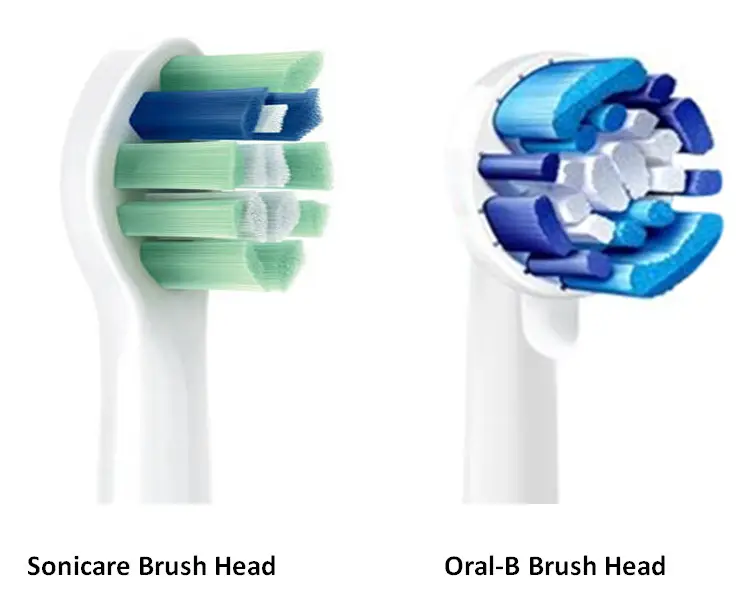
UV Sanitizer – Only Philips offers this, a little box with UV lights inside to kill bacteria on brush-heads. It’s hard to say whether these are a valuable addition or a gimmick to inflate prices.
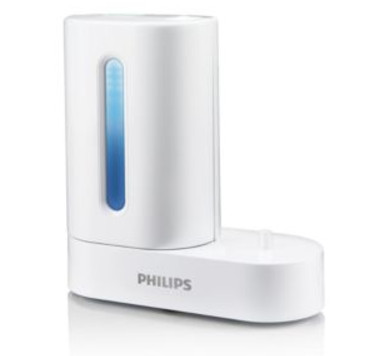
Tongue Cleaning Mode – Both brands offer this on high-end toothbrushes and Philips also offers a tongue-spray, but in all honesty, it seems pointless.
Glass Charger – The Philips DiamondClean model comes with a glass that doubles a charger. You can also use it to rinse your mouth. It works and looks very nice. A “clear” win for Philips there.
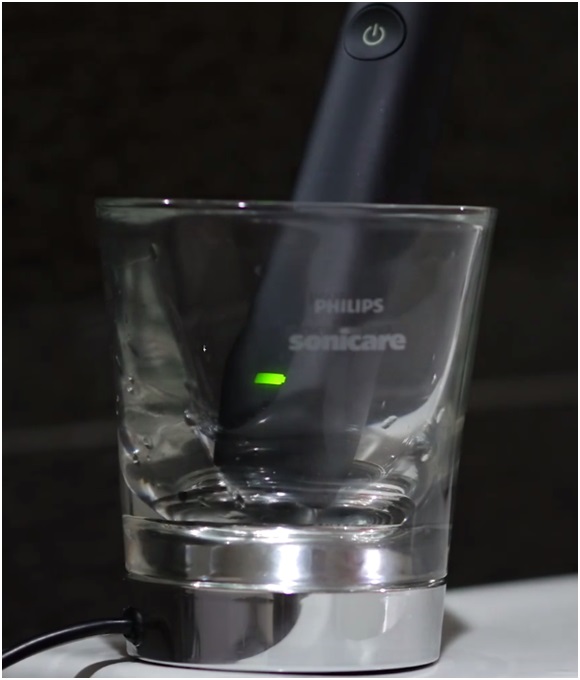
Wireless Charging – A Philips-only offering that simplifies plugging in. It’s great for those in a hurry.
Conclusions and Suggestions
Both of these brands have come up with electric toothbrushes that undoubtedly do a great job of cleaning teeth. At the start, we suggested that comparing them is like comparing apples and oranges, but in a sense, the main attraction of both is this ability to do a hugely better job of keeping your mouth in tiptop health compared to a manual toothbrush. It’s more like comparing Pink Lady apples with Golden Delicious apples. Out of all of the extra features that Oral-B and Philips make available, none of them seem absolutely essential. They are optional extras designed to make brushing a little more enjoyable, a little more comfortable, but none of them seems indispensable.
So, when buying, it makes sense to choose a brush with features that you know you will actually value. For instance, wireless charging could be really useful to you if you are always traveling, always in a hurry and have other Qi-enabled devices could use the same charger.